QuestionI have a 10 week old yorkie and she is constantly peeing all over the house, is there something wrong with her. We take her outside to handle her business but when she is back in the house she is constantly peeing. She won't even pee on the puppy pad, is there a serious problem here.
AnswerShe is only 10 weeks old, so no I wouldn't say theres a big problem here yet. If she pees a lot more than she should, I mean if it's just ridiculous amounts then yes there may be a urine infection, but at this age pups are often rogues when it comes to peeing in the house. Puppy pads are counter productive, because basically your saying OK you can pee in the house if you do it here, and most pups won't distinguish the difference.
Unless you can monitor your puppy 24 hours a day, don't expect the house training process to be completed until your puppy is at least 6 months old. It's normal for a young puppy to be a little 'input-output' machine. Since puppies are growing and developing rapidly at this stage, they eat more food, burn up more energy and seem to need to eliminate constantly! They also have not yet developed bowel and bladder control, so they can't 'hold it' as long as adult dogs.
Ok. Lets get a plan to fix it.
Successful housetraining depends mostly on the humans involved in the process. By using prevention instead of punishment, with vigilance, reasonable expectations, and by using a puppy's natural instincts, housetraining can be accomplished painlessly and in a reasonably short time. Breed and/or sex have no impact on the ease or difficulty of teaching your puppy to eliminate in a specific area (be it outdoors, on newspapers, or in a kitty litter box.)
Puppies are instinctively clean. From birth, they leave the pile of sleeping littermates and go as far away as possible to eliminate. Unless forced to do so, puppies will not soil their bed and this instinct is your greatest training aid.
The younger the pup, the less time between impulse and action. He needs to eliminate, so he does. Punishing or even scolding a very young puppy has no more effect than it would have on an infant in diapers. Fortunately, a puppy will train a whole lot faster than a baby!
Before we go any further, let me assure you that confining your dog is not cruel! In the wild, canines instinctively seek out small enclosed spaces in which to make their dens. If you have obtained your puppy from a reliable and knowledgeable breeder, your puppy will be accustomed to being confined and will accept this in your home, provided you do not allow him the run of the house.
It is far more cruel to give a dog that is untrained too much freedom, too fast, which guarantees puddles and messes all over your house. The puppy becomes subject to constant reprimands, which will probably be after the fact, so he has no idea why you are upset; you are frustrated by the unpleasant task of cleaning up after him, and having your good carpet soiled; and things might get so bad that you either put the dog in exile in an outdoor kennel, or you recycle him.... or even have him destroyed.
Which is worse? Being euthanized, spending your life alone in a backyard, or spending part of every day in a comfortable and safe area?
Before you bring your puppy home, decide where and in what, he is going to sleep. Strongly recommended is the crate, a wire or fiberglass and wire enclosure, big enough for the puppy to stretch out in comfortably, but not big enough for him to have a sleeping and "bathroom" areas. If you have a puppy of the large or giant breeds, and expense is a consideration, you may want to purchase the size crate your dog will need as an adult and partition it off, giving him more room as he grows.
Another option is a discarded baby playpen, with wiring fastened around the outside of the slats to insure that the pup can't get caught between them or wriggle out. Collapsible fencing or commercial exercise pens, attached to a wall or walls can be used to enclose an area. Baby gates or commercial dog gates can be used to enclose a small area.
The crate has a decided advantage over these other options in that it is portable. Puppies and dogs need companionship, and the crate can be moved from room to room (although you may find yourself, like many doggie folk, with crates in many rooms. They make handy end and coffee tables!). It is also a benefit if your dog is crate trained, should he have to stay confined because of illness or surgery. In case of automobile accident, it is safer for your dog if he is travelling in a crate, rather than loose in the car. There may be times when you want to protect your dog from untrained children, or you may have company who is afraid of dogs. Many hotels and motels will only accept dogs if they are crated.
The crate is the dog's bed, his haven, and as he earns his freedom in the house, you will find that you can leave your crate open, and he will go in and out at will. It is his place, his den, and he feels safe and comfortable there.
Don't put anything in the crate for bedding. Did you ever wonder why, if there was one tiny throw rug in the midst of a sea of linoleum, your dog or puppy always messed on the rug? It's because of Rule Number 2: dogs always seek the most absorbent place to do their business. Since we don't want the puppy to get the idea that we want him to soil his crate, don't put a blanket or towel, or even a canvas covered crate pillow inside, yet. Later, after the puppy has demonstrated cleanliness in the crate, you may do so.
Ideally, your puppy will come to you already crate-trained. However, not all puppies have ideal beginnings, so you may have to introduce your puppy to the crate.
One way to introduce the crate is by removing the door and surrounding it with an exercise pen, where the exercise pen area can be covered with newspapers if the puppy must be unsupervised, or if you must leave the puppy alone for more hours a day than he is capable of regulating his eliminations. This arrangement allows the puppy to keep his bed (the crate) clean. Feed the puppy in his crate, and if he is reluctant to go in to eat, put the bowls just in the doorway, so he can stand outside and eat with only his head inside. At each meal, put the bowls an inch or two further back, until he willingly goes in to eat. Also keep a few toys in the crate.
When he is comfortable eating in the crate it is time to teach him to stay quietly inside while confined. Put the door back on the crate. This time, when you feed him, close the door. As soon as he is done eating, let him out and take him to his potty area.
Generally, a puppy should only be confined as many daytime hours as he is months old before being taken out to relieve himself. That is, an 8 week old puppy will need to go out every two hours during the day. Doubling that for the night would mean that an 8 week old puppy should be taken out every four hours during the night. A 12 week old pup would go 3 hours during the day and 6 at night; a 16 week old would go 4 hours and give you an 8 hour night. These are guidelines, of course, and every puppy is a little different. You may get lucky, and have one that will sleep the night from day one, or yours may take a little longer to get there.
Very young puppies need to go out first thing in the morning, immediately after eating and/or drinking, after playtimes, immediately upon waking, and immediately before you retire for the night. Then, if there is any time left, take him out according to the schedule outlined in the previous paragraph.
Your personal schedule may not allow you to follow the schedule rigidly. If there is any way for you to adjust your schedule for a few weeks to allow you to accommodate the puppy's needs, you will be repaid in a short time with a dog that is reliably housebroken. If you cannot adjust your schedule, then please adjust your mindset to accepting the fact that it will take a little longer for your puppy to get the message. If you know you are going to be gone for more hours than your puppy can reasonably be expected to control himself, then make it easy on both of you. Suspend your attempts to housetrain during that time, put him in an area where he can leave his bed (crate) to eliminate. The crate surrounded by an exercise pen described previously works fine. Just put down plenty of newspaper for the pup to use while you're gone, clean it up when you get home, and go on with your training. Quite often, once the pup develops the muscular control, he will try and wait for your return, in spite of having those papers available.
If you are using newspapers, take note of where your pup makes his deposits. Gradually start removing the papers around this area, until you only have to leave a small section covered for him.
It is generally best to carry the puppy outside because the pup's bowel and sphincter are stimulated by walking. Set him down where you want him to go and then you just stand in one place until he goes. Always go with your puppy, even if you have a fenced yard. Your being there is the only way to know if he has relieved himself and you cannot give timely praise if you can't see what he is doing.
You can teach you pup to relieve herself on command by telling her to "Go potty" or "get busy" (or whatever words you want to use) just as she starts to relieve himself. Praise quietly while she is going (don't distract her!) and then give enthusiastic praise and a treat (if you use them) when she is done.
If your pup does have an accident in the house It is your fault for failing to prevent it. Do not punish the puppy. If you catch him in the act, don't let him finish. Pick him up (you can give one low,growling "anghhh!" of disapproval) and take him outside. Wait with him until he finishes, then praise. When you bring him back in, put him in his crate while you clean up. Make sure you use one of those scent removing solutions, such as Simple Solution, to remove all traces of odor. If the odor is not completely neutralized the dog will be attracted back to the same place. In a pinch, seltzer works pretty well.
Once the pup has the idea of housetraining, you can teach him to signal you when he needs to go. If your dog hasn't already developed a signal by himself, decide what you want him to do. Some options are barking, going to the door and scratching, or even ringing a bell.
Teach him the signal as a separate exercise. I strongly recommend using clicker training to teach the new behavior.
When you recognize his need to eliminate, ask him, with some enthusiasm, "Do you want to go out?" Put on his lead, and take him to the door. At the door, have him perform his signal behavior. Click/treat and take him out. (Or if he really needs to go, click and treat after he potties.) If you opt not to clicker train, use praise and/or treats instead, but otherwise, follow the same procedure. Before long, your pup will automatically give you the signal in response to your "Do you want to go out" question, and shortly thereafter, he will initiate the signaling behaviour when he needs to eliminate.
In all fairness, though, do not tease him with the "out" question by not following through. If you do, the question will lose it's meaning and confuse the dog.
I know it's a lot, but this will work.
Good luck!!

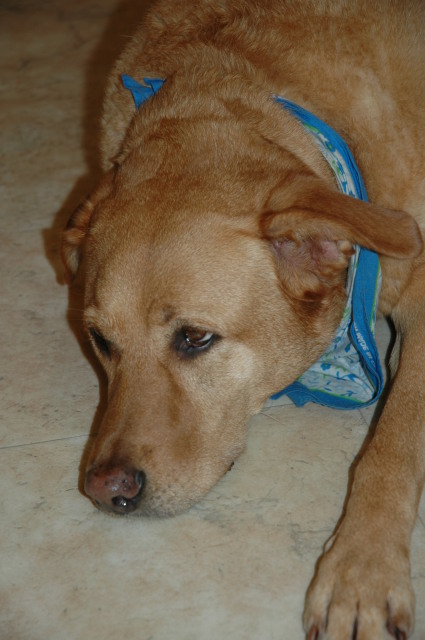 Senior dog not eating
Question
Meggie Girl
I will be so grateful if you can h
Senior dog not eating
Question
Meggie Girl
I will be so grateful if you can h
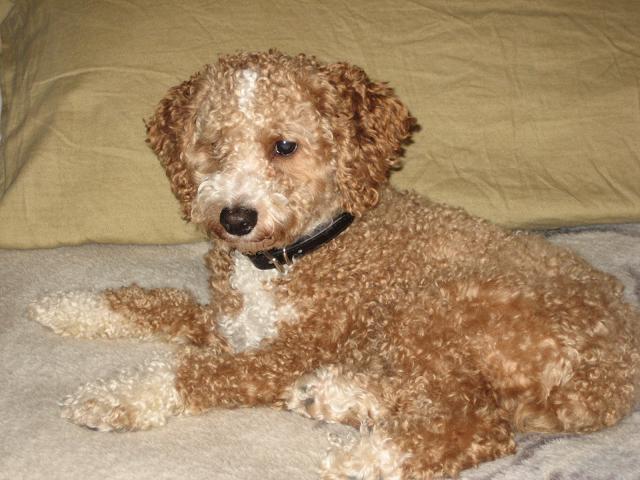 cockapoo agression
Question
Pets11.jpg
We have had our Cockapoo (Tyson) si
cockapoo agression
Question
Pets11.jpg
We have had our Cockapoo (Tyson) si
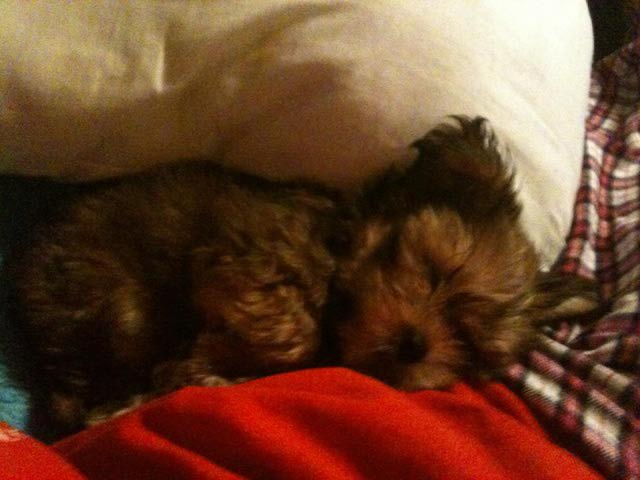 willpups hair grow back to original color
Question
here is his color befo here is after &nb
willpups hair grow back to original color
Question
here is his color befo here is after &nb
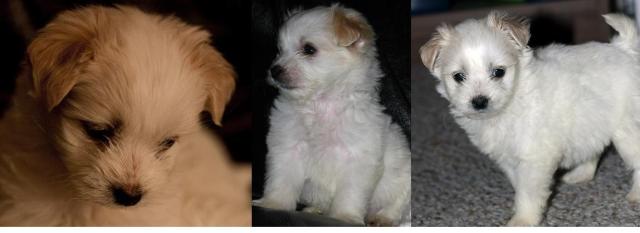 maltese with brown ears
Question
maltese
we bought a dog and owner said its pur
maltese with brown ears
Question
maltese
we bought a dog and owner said its pur
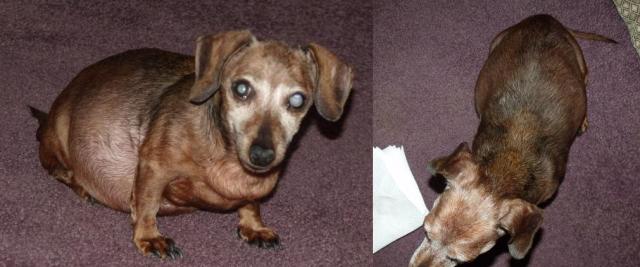 Older dog with distended stomach.
Question
Belle
Hi, my 14 year old miniature dachshund,
Older dog with distended stomach.
Question
Belle
Hi, my 14 year old miniature dachshund,